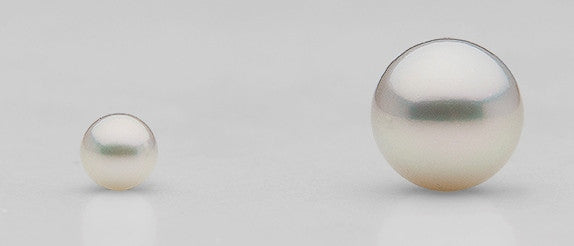Pearl Size: Volume vs Diameter
We're often asked for advice when customers are trying to determine what size of pearl is best suited for them. The question is typically whether or not it is worth it to go up a size or two in millimeters. Is the difference really that noticeable?
The image below is of a 6 mm akoya pearl next to a 12 mm South Sea pearl. The millimeter size is exactly double, but it's easy to see that the true difference in size is much greater.
6 mm akoya pearl next to 12 mm South Sea pearl
As a rule of thumb, I've always told customers that a 2 mm incremental increase in millimeter size would approximately double the overall size of the pearl. On the surface this tends to be confusing. How can an 8 mm pearl be twice the size of a 6 mm pearl?
Pearl Dreams, a pearl enthusiast from Pearl-Guide.com's community forum produced a brilliant explanation that I plan to incorporate into our team training. It isn't so much the millimeter size that determines the true size of a pearl. Given that pearls are three-dimensional objects, the volume is what truly determines the size.
By determining the volume of perfectly round pearls (V = ⁴⁄₃πr³) in 1 mm pearl increments, Pearl Dreams was able to show that a small increase in pearl mm size can have a large impact on the true size of a pearl.
12 mm pearl: 904 cubic mm (30% larger than 11mm and 73% larger than 10mm; over 3 times as large as 8mm)
11 mm pearl: 697 cubic mm (33% larger than 10mm)
10 mm pearl: 523 cubic mm (37% larger than 9mm, 95% larger than 8mm)
9 mm pearl: 382 cubic mm (43% larger than 8mm; 2 times as large as 7mm pearls)
8 mm pearl: 268 cubic mm (49% larger than 7mm)
7 mm pearl: 180 cubic mm (59% larger than 6mm)
6 mm pearl: 113 cubic mm
Pearl Dreams went on to describe a formula to determine the volume for a prolate ellipsoid, which can be related to oval pearls.
This is likely the best explanation I've ever seen on this subject.







Hi, My query is I have 7 MM pearl for sizing. How much it would be in carat?
That picture is really really cool, I was just at the Shenzen show I am sure the show in Hong Kong is going to be awesome.
Graeme
You have the right idea – but the type of pearl matters, specifically because of the nucleus. Akoyas are simply cultured nucleus pearls more or less, and the nucleus may depend on the grower. This is why this method is nearly perfect for freshwaters, which are basically pure pearl (also could be a pure pearl nucleus inside a pearl with no space in between from the same mussel).
For a spherical argument, one could easily derive a very slightly loose estimation of a pure freshwater from another by either the radius or diameter. Just use this concept that a 10mm pearl is 6.5 carats, and that densities are homogeneously distributed, and that there is no clay ball in the center. Now compare that to every other “pure pearl” in the world that is spherical and you come up with this argument to compare length 1 (L1) and length 2 (L2) of two different pearl specimens:
((L1 divided by L2))¨to the dimension power (being 3 for sphere) is proportional to the ratio of the volumes. Use L1 being the unknown pearl and L2 being the 10mm 6.5ct pearl, and you derive your whole chart naturally and as needed. For instance, if you want to know how many carats is a 3mm FW pearl with the 10mm pearl being 6.5cts, then it is just (3 over 10) to the third power = x over 6.5cts. It follows x = 0.1755cts. Ironically, a 3mm diamond RBC would be about 10 points depending on the make of course, but the derivation is similar: a 6.5mm RBC is 1ct. SO If I have a 3mm spherical pearl that weighs over 0.2cts, then it has something inside it or something is odd about it if a 10mm pearl is 6.5cts (this is basically the standard for ancient Thailand). One can use this method on gemstone spherical beads as well if you know the control item well. Since science does not lie, the lies in what people are selling become more obvious as the items get examined closely.
Now, when the pearl is egg shaped, then you can just average the mm size based on what you can measure with a vernier caliper and after you do this you will be off by a consistent amount specifically predicable based on the consistency of variation in curvature. One would probably be able to see this with the naked eye even with poor vision, and so would know what to expect.
Now, when densities are not homogeneous, and when you have unknown sized nucleus inside the pearl, the actual weights of the pearl usually end up being significantly different by comparison to the “pure pearl”. This explains the "akoya " as well as the “shell pearl” to some degree. Another problem is akoyas do not withstand a salinous atmosphere well enough and I would avoid them, or only invest for the purpose of selling the Brazilian government Central Bank, aka the “Caixa.” The only problem is that with them it is just “we buy gold” so if one has to rely on the gemology of the Caixa, then it needs to be self contained within the standards of “take it for granite” with goal parallelism to gemology and the truth of the world demands. Brazil indeed supplies granite if you are interested, and there are construction business all over, especially in rural areas. Although gemology is not an extinct science, it certainly seems that way here! Are dinosaurs really walking the planet of gemology in Brazil – either way, the show must go on!
I believe in volume.
We were recently comparing my 40 inch television to my mom’s 80 inch television. Four of mine could easily fit in her screen. Super Bowl should be very good this year! :)
Great photo!
Leave a comment